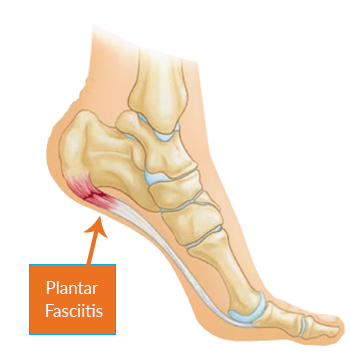
Are your first steps out of bed in the morning accompanied by stabbing heel pain? Well, you might be suffering from plantar fasciitis, and you are not alone. As a matter of fact, nearly 10 % of the population will suffer from this painful condition.
What is Plantar Fasciitis?
Plantar fasciitis is known as a runner’s condition. However, that is not the only way someone can get this stabbing pain in their foot. This condition occurs when the plantar fascia (the tissue which connects your heel to our toes) becomes inflamed.
Thankfully, with the right treatment, this nagging condition typically goes away within a few months. For a quick and speedy recovery, you should visit your physician if the pain does not subside within a few days.
What are the Symptoms?
Typically the number one complaint from someone suffering from plantar fasciitis is the stabbing pain on the bottom of the heel. Which, over time, gradually worsens. Foot pain associated with this condition is usually described as stabbing, however, at times people complain of dull pain.
Additional symptoms are as follows:
- Worsens with first few steps in the morning
- Stabbing pain
- Triggered by long periods of sitting or standing
- The pain worsened after or during exercise
Risks & Causes of Plantar Fasciitis
There are many risk facts of plantar fascitis, the top is being overweight or obese. This occurs due to the sudden increased pressure on your plantar fascitis ligaments, typically with sudden weight gain. Often, during pregnancy, women will also receive bouts of plantar fasciitis, usually during late terms.
Who is at risk?
- Long-distance runners
- An active job that requires you on your feet often
- Men & women ages 40-70 are at high risk
- Structural foot issues
How is it Diagnosed?
First, your physician will examine your foot to make sure there is no tenderness and check the specific location of the pain. Your doctor might then ask you to flex your foot while they apply pressure to the plantar fascia. This is done to see if the pain gets worse as you flex and better as you point your toe.
Your doctor will evaluate your nerve strength by doing the following:
- Reflexes
- Muscle tone
- Sense of touch and sight
- Coordination
- Balance
An X-ray or MRI scan may also be necessary to ensure its the correct diagnosis.
Plantar Fasciitis Treatment
If you do in fact have plantar fascitis, there are several options your doctor has to treat this condition, such as:
Medication: Nonsteroidal anti-inflammatory drugs (NSAIDs) will help with your pain and reduce inflammation of the plantar fascia. Your doctor may prescribe multiple doses a day for several weeks.
Physical Therapy: If you are not showing symptoms of recovery after the medication is administered, and the RICE method is applied, your physician might suggest physical therapy options.
Steroid Injection: If your pain is severe or does not respond to prescribed NSAIDs, you might want to think about getting a steroid injection.
If you are not showing progress after a few months of the above therapies, shock wave therapy might be considered.
Shock-wave Therapy: When this is performed, it shocks your plantar fascia with sound waves. This therapy stimulates blood flow in the foot and helps the tissue heal. Plus, it also stuns your nerves to stop the pain.
Tenex Procedure: You only need a small cut, and it’s usually over in a few minutes. An ultrasound is used to target and remove scar tissue. This procedure allows you to get back to your regular routine in as little as 10 days.
If you are looking for a foot & ankle specialist, call us at 888-409-8006. Offices are conveniently located in South Florida in Boca Raton, Deerfield Beach & Plantation.
